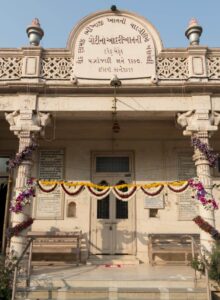Second Only To Iranshah And Navsari’s Vadi Dar-e-Mihr
Courtesy: Er. Adil J. Govadia
 Indeed, the history of Surat’s Goti Adarian remains a mystery. There is no record available as to its exact date of consecration or names of priests who consecrated the Adarian Saheb. Very limited details are available regarding its antiquity which is reproduced in this article…
Indeed, the history of Surat’s Goti Adarian remains a mystery. There is no record available as to its exact date of consecration or names of priests who consecrated the Adarian Saheb. Very limited details are available regarding its antiquity which is reproduced in this article…
The origins of Surat’s esteemed Goti Adarian continue to remain a mystery, as very little is known or documented about this primeval fire temple. Originally housed in the vicinity of Rafi Burj, an ancient fortress on the banks of Tapti (Tapi) River, the temple’s structure has, over the past millennium, undergone several renovations, alterations and transformations. Undoubtedly, many Zoroastrians continue to hold the fire’s sanctified status second only to the most revered Iranshah.
Although the origins of the Goti Adarian are unknown, according to late Roni Khan’s family folklore that appeared in the Mumbai Samachar’s ‘Parsi Tari Aarsi’ (1975), a poor farmer found a ball of fire lying in his field. Recognizing Parsis’ religious sentiments for ‘natural fire’, he brought it to the notice of the local Parsi community who quickly gathered the fire for eventual consecration. Since the fire was in the shape of a ball, it acquired the name ‘goti’.
According to Er. Barjorji Erachji Bajan’s treatise, as documented in ‘Parsi Din Aain Ane Tawarikhi Tarang’, the history of Goti Adarian dates to the 14th century (around 1393 AD), when the first batch of Parsi priests migrated to Surat. It was perhaps in this period that Goti Adarian was enthroned in Surat, much before any other Adarian or Atash Behram – barring of course, the holy Iranshah and Vadi Dar-e-Mihr in Navsari. Such is the exalted status of Goti Adarian in its antiquity, second only to the most glorious Iranshah and the Vadi Dar-e-Mihr.
Bomanji Behramji Patel’s magnum opus, ‘Parsi Dharmasthalo’, published in 1894, however states that this ancient, sanctified fire temple was originally established in Surat by a Mobed (priest) named Goti, who hailed from Khambhat. He established the Agiary building on a small piece of land owned by Seth Sorabji Cawasji Neksatkhan* which was later demolished for a larger building, thanks mainly to the munificent contribution of Seth Nusserwanji Coyaji. This new edifice of Goti Adarian was thus founded on April 7th, 1796 (Roz Hormuzd, Mah Meher; YZ 1165).
(*Note: Seth Sorabji Cawasji was a Parsi merchant from Surat who presumably received a title of nobility called ‘Nek Sat Khan’ because of his expertise in clock repair which greatly impressed the Delhi Durbar of the period. Eventually, his later generations adopted the title ‘Nek Sat Khan’ as a family surname, which subsequently got shortened to ‘Khan’.)
While the exact origins of Goti Adarian remain indeterminate, the fire-temple’s edifice has, over the past ten centuries, undergone several renovations and reconstructions funded by magnanimous donors including Sir Jamshedji Jeejeebhoy, Seth Dadabhoy Pestonji Aipaiwala, Seth Meherwanji Hormusji Frazer, Seth Nussarwanji Bomanji Bhawnagari etc. In 1841, Seth Rustomji Mancherji Fali Patviwala donated a substantial amount towards the upkeep of Goti Adarian. In 1853, Seth Dosabhai Cawasji Vasanwalla, not only donated magnanimously, but also managed the day-to-day activities of the religious institution. Later, his grandson Seth Nusserwanji Framji Vasanwalla continued the family tradition of managing the Goti Adarian.
Thereafter, on 12th May, 1857 (Roj Behram, Mah Meher), a new building was inaugurated to house the Goti Adarian Saheb, thanks to the munificence of Bai Hirabai Jehangirji Panthaky, widow of Seth Jehangirji Manekji Panthaky, from Mumbai. In 1894, the maintenance of Goti Adarian was undertaken by Seth Munchershaw and his brother Seth Bhikhaji Framji Khan, whose generous patronage facilitated the upkeep of the Adarian Saheb.
Immediately, after World War I (1921), the Khan brothers constructed a new structure to house the Adarian Saheb, in memory of their late father Seth Framji Bhikhaji Khan. In 1976, it was decided to move the Fire to its present location, a few kilometers inland from the riverbank, due to recurrent floods and resultant hazard posed to the holy fire by the surging waters of Tapti River.
On 5th December, 2003, the crumbling structure of Goti Adarian was once again renovated at an exorbitant cost, thanks to the generous magnanimity of Palonji Mistry and his sons Shapoorji and Late Cyrus Mistry of M/s Shapoorji Pallonji & Co.
As per a 2019 news report, the Salgreh of Goti Adarian was celebrated on 1st December, 2019 (Roj Sarosh-Mah Tir) when a Hama Anjuman Maachi was offered by Panthaky Er. Meherzad P. Turel, a seventh generation Mobed from the illustrious line of Turel family. Young Er Zahan*, a newly ordained Mobed and son of the present Panthaky, Er. Meherzad Turel, is now destined to continue the Turel family’s legacy.
(*Note: On 24th October, 2020, young Er Zahan M. Turel unfortunately suffered 50% burns on his entire upper body, neck, hands and ears while performing the Boi ceremony at the Goti Adarian. He was rushed to Masina Hospital, Mumbai.) With God’s grace and excellent medical treatment at the hospital, young Er. Zahaan was discharged on 4th January, 2021.
Undeniably, the stories of how the fire was often rescued from the rampaging and rising waters of the Tapti River has added much mystique to this glorious fire temple!
- તમે ઇન્જેક્શન આપેલા તરબૂચ તો નથી ખાઈ રહ્યા ને? - 27 April2024
- પિતાના હાથની છાપ.. - 27 April2024
- વિસ્પી ખરાડી ફિટ ઈન્ડિયા મૂવમેન્ટનાબ્રાન્ડ એમ્બેસેડર તરીકે નિયુક્ત - 27 April2024
